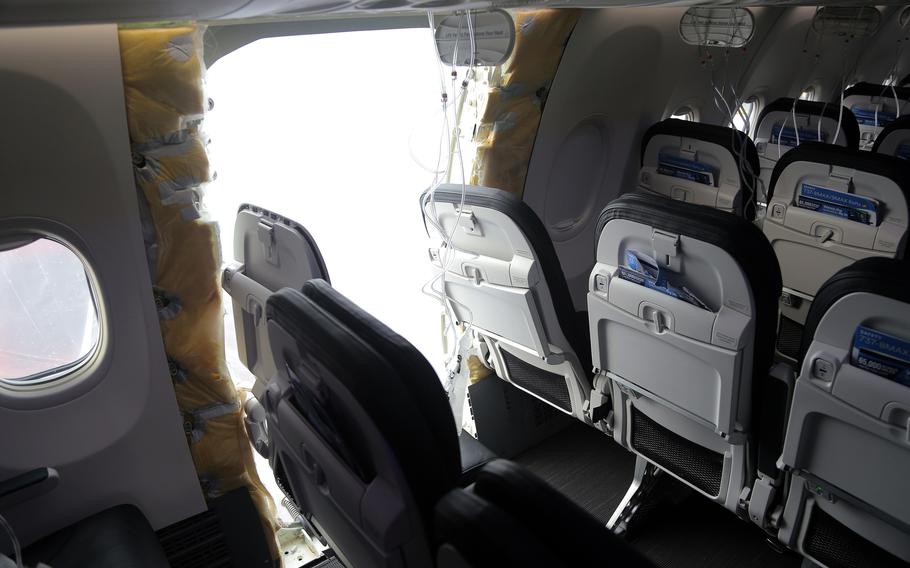
A door-sized section near the rear of the Boeing 737-9 MAX plane blew off 10 minutes after Alaska Airlines Flight 1282 took off from Portland, Ore., on Jan. 5, 2024, on its way to Ontario, Calif. (National Transportation Safety Board)
The emergency grounding of Boeing’s 737 Max 9 jetliner cost United Airlines $200 million in the first three months of this year, the airline said, blaming the disruption for its failure to turn a quarterly profit.
The airline reported net losses of $124 million in 2024’s first quarter, though it described its overall financial and operational performance in the period as “strong.” United’s Tuesday statement also pointed optimistically to a broader hike in demand for air travel, as compared with before the pandemic, fueling its own plans to grow its network. In 2023, the airline reported a net loss of $194 million in the first quarter, and a net income of $2.6 billion for the full year.
Tuesday’s report caps off a turbulent quarter for United. After the door plug of an Alaska Airlines Boeing 737 Max 9 blew out midflight in January, federal agencies grounded dozens of Boeing planes and limited the manufacturer’s ability to deliver aircraft on time — forcing United to cancel thousands of flights, reformulate schedules and pause hiring.
After the blowout, the Federal Aviation Administration grounded 171 planes with the same plug door design, 79 of which belonged to United. The three-week emergency grounding led to widespread disruption for both it and Alaska — the only other U.S. carrier to have the 737 Max 9 in its fleet. The airlines canceled thousands of flights each as schedulers sourced alternative aircraft to transport stranded passengers.
In addition to temporarily grounding the model, the FAA also announced that it would be applying deeper scrutiny to Boeing’s manufacturing processes — delaying the delivery times on existing aircraft orders for carriers, including United.
The FAA also imposed a monthly limit on the number of 737 Max jets that Boeing can manufacture until the agency can ensure the company is abiding by its own quality control procedures. It delayed the certification and deliveries of Boeing’s 737 Max 10, a larger version of the Max 9 of which United originally ordered 277 in 2017.
To cope with delays to delivery schedules, United paused the hiring of new pilots for May and June, and even urged its pilots to take unpaid time off from May. Union officials told United pilots that “recent changes to our Boeing deliveries” were the reason for the offer of voluntary time off, The Washington Post reported at the time.
On Tuesday, United announced that it adjusted its “fleet strategy” to reduce its reliance on the Max 10 in the next few years, and converted some of its existing orders of Boeing Max 10s to the Max 9. It also announced it had signed “letters of intent” to lease 35 new Airbus A321neos, expected in 2026 and 2027 — a key rival to the Max 10.
“We’ve adjusted our fleet plan to better reflect the reality of what the manufacturers are able to deliver,” United CEO Scott Kirby said in a statement.
A preliminary report by the National Transportation Safety Board after the Alaska Airlines blowout found that four bolts designed to secure the door plug were missing on the Max 9 jetliner. A FAA audit also identified significant weaknesses in Boeing’s quality control and assurance programs, setting the aerospace giant a deadline in late May to formulate a plan that would address the issues. Boeing said it had launched new protocols for inspecting the manufacturing process and documenting subsequent adjustments to the panel.
When reached for comment on this story, a Boeing spokesman referred to comments made last month by its chief financial officer, Brian West, in which he said the company had put customers in a “tight spot” and that “the most important thing we do is communicate with them. And they have been supportive of everything we’re trying to do to enhance safety and quality for the industry.”
In January, Alaska estimated that the grounding of the 737 Max 9 would cost the carrier $150 million. In subsequent regulatory filings, reported by the Associated Press, Alaska disclosed that it had received a $160 million “initial compensation” payment from Boeing to cover the pretax losses related to the blowout. United did not immediately respond to a request for comment on whether it sought similar compensation from Boeing.
Lori Aratani contributed to this report.